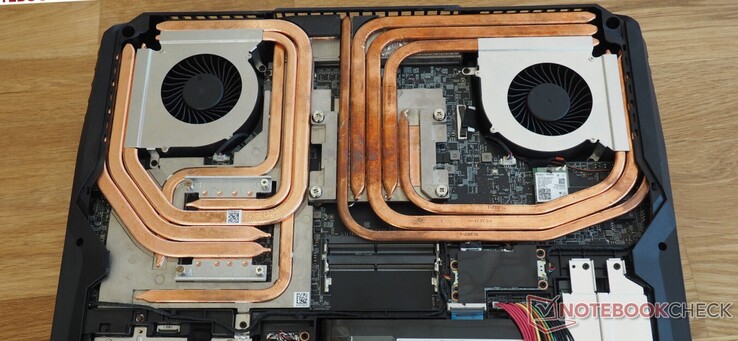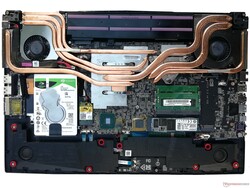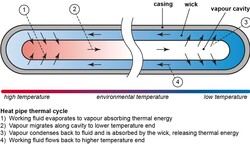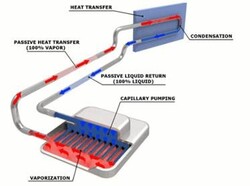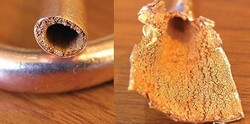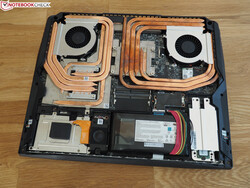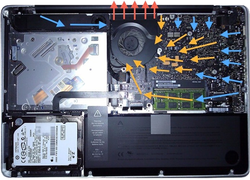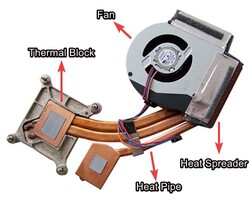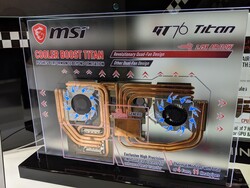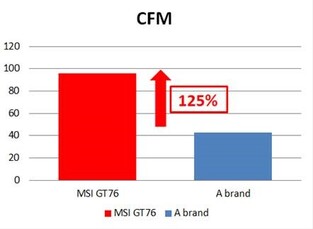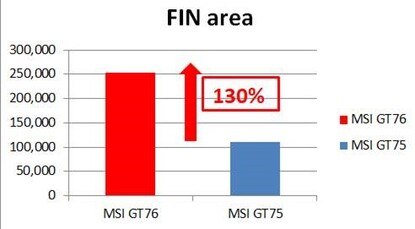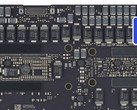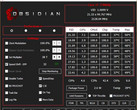Laptops 101: Understanding what goes into designing an efficient laptop cooling solution
Introduction
So, you've just gotten your hands on an absolute beast of a laptop that is slim yet powerful and can theoretically give you all the frames you need for gaming world domination. After setting it up, you fire up the game in glee hoping to be the last person standing. Thirty minutes into the game, you find that your frames are dropping fast and the laptop is as hot as a blast furnace. Seems like the specs couldn't quite match up to the real-world performance, after all. What just happened was you've experienced speed throttling due to inadequate cooling.
The importance of proper cooling in laptops cannot be overstated. Regular readers of Notebookcheck will be aware of the many articles in which we have time and again emphasized the need to properly evaluate the cooling systems of laptops that use flagship components and the associated pitfalls of throttling. Improper cooling can result in significant performance loss and you may ultimately end up paying more for a laptop that actually performs less.
When buying a laptop, understanding how the OEM implements the cooling mechanism is one way to infer the potential for good performance. The available headroom for cooling in a laptop is way lesser than what you get in a desktop PC, so OEMs have come up with innovative ways to keep components like a full desktop-class Intel Core i9-9980HK and an NVIDIA GeForce RTX 2080 buzzing without much of a hiccup.
In this article, we will take a look at what goes into designing an effective cooling solution, including the choice of components and prototyping that goes into this process along with some of the improvements that OEMs have managed to make in recent times. Interested in knowing what goes into making a laptop such as the MSI GT76 run all 8 cores on 5 GHz? Read on.
Designing a capable thermal solution
Designing a good thermal solution that can encompass the heat dissipation requirements of key components such as the CPU, GPU, and VRMs is not a trivial matter. A lot of factors and testing go into trying to understand how much heat the chips generate and how well they can fit into the particular laptop form factor.
The process of designing a laptop's cooling solution is a very important aspect of the R&D process and this usually occurs as detailed below. Note that while each OEM will have its own proprietary way of designing the thermals to maximize performance, the concepts involved in use of thermal blocks, heat pipes, heat spreaders, and fans are applicable across almost all manufacturers.
A "chip" off the old thermal block
Have a look at the internals of the MSI GP75 Leopard pictured alongside. This is a very capable laptop for 1080p gaming and is powered by the Intel Core i7-9750H and the NVIDIA GeForce GTX 1660 Ti. From the image, we get to see multiple copper heat pipes that travel away from the CPU and GPU towards the fans. If you look closely, you can see that these copper pipes actually lead away from a copper block that is present on both the processors. This copper block, or thermal block if you will, makes contact with the actual CPU/GPU via a thermal paste. So the heat transfer occurs as CPU/GPU > Paste > Block > Heat Pipes. The idea is to transfer the heat from the chip as fast as possible to the thermal block for efficient dissipation. Why is this important?

Without going into too much detail, each chip is rated to dissipate a certain amount of heat when operated at its rated TDP. While there is no consensus among chip makers as to how the TDP is calculated, OEMs do their own testing to see how far this TDP can be pushed within a given chassis size. Now, if the heat is not drawn away from the chip in a timely manner, the increased heat envelope around the chip forces it to operate at a lower frequency to prevent damage, thus affecting performance. A case in point is how the 2018 Apple MacBook Pro with Core i9 initially could not even attain the rated boost frequency due to poor thermal design.
Also, excess heat means that the chip will work at a lower efficiency in the clock cycle and although it may appear to hit the required frequency, the overall performance is compromised. The ability to overclock is severely hindered as well.
Therefore, it is important that heat is drawn away from the chip with high efficiency and in the least time possible. Copper is the preferred choice for thermal blocks due to its high conductivity. The copper block in most laptops has a rough surface, which at the microscopic level does not allow for a thorough contact with the grease. To circumvent this issue and offer even more efficient conductivity, the more powerful gaming laptops such as the MSI GT76 use a CNC polished copper block to maximize the surface contact area, which aids in better heat dissipation away from the processor.
Good thermals is still a "heat pipe" dream
So, now that we have removed heat from the chip in an efficient manner, we need to channel this heat away from the CPU/GPU assembly by way of heat pipes. A heat pipe is comprised of an evaporator section and a condenser section and is technically referred to as a two-phase heat transport system. In a heat pipe, a liquid (usually water) absorbs the heat from the thermal block and gets converted into vapor (evaporator section) that travels along the pipe's cavity to a region of lower temperature (condenser section). Here, the vapor condenses to liquid, which is reabsorbed by a wick and flows back to the original position by capillary action while the heat is dissipated outside.
As an example, consider the accompanying diagram. We see that the liquid in the heat pipe gets heated up into vapor, travels to the heat transfer area, transfers the heat, and condenses back to liquid form. The part labeled "Vaporization" can be likened to the heat block we discussed above while the "Heat Transfer" area is akin to the heat spreader fins that we'll be seeing shortly. This is how heat is transferred from the thermal block and ultimately on to the heat spreader fins where the heat is then pushed out via fans.
Heat pipes are usually made of copper or aluminum and the wick structure inside is either grooved, a wire mesh (wrapped screen), sintered, or fiber. Of these, sintered pipes are the most expensive to manufacture but offer excellent heat conduction from the wick to the wall and vice-versa.
While the wick structure is a key criterion for selecting the right heat pipe, there are several other factors that must be equally considered for efficient heat-pipe performance. The first of these is the quantity — the more the number of heat pipes, the better is the heat transfer from the thermal block to the pipe. However, deciding on the number of pipes depends on the overall thermal output from the block and the surface area available.
The length and diameter of the pipe directly affect the rate of vapor travel within the cavity. The larger the diameter, the more vapor volume that can be transmitted. The length of the pipe must not be too long. Shorter pipes can transmit more heat than longer ones and shorter pipes also have higher capillary limits — the rate at which the fluid returns from the condenser to the evaporator.
Many laptops often run heat pipes across both the CPU and GPU. While this saves costs, the part of the pipe between the CPU and the GPU is relatively cooler, which can result in premature condensation of the liquid hampering heat transfer efficiency. Therefore, in high-end gaming laptops such as the MSI GT76, the CPU and the GPU have their own corresponding heat pipes and fan assemblies for maximum heat transfer.
Since a laptop does not have enough room to accommodate a cylindrical heat pipe, the pipe must be flattened before it can be used in the thermal system. This adds another layer of complexity as uneven or excessive flattening can impede liquid transfer within the wick. Tight bends are also detrimental. However, it has been shown that as long as the bend radius is 3x that of the pipe's diameter, the performance is unaffected.
Better airflow ensures a cooler laptop
Successfully transmitting heat away from the processor is only half the job done. Getting the heat completely out of the chassis is equally challenging. This is where heat spreaders and fans come in. At a very basic level, the heat spreader increases the surface area for the heat coming from the heat pipe while the fan drives away this heat by drawing in cool air from the outside.
Deciding on the kind of fan and heat spreader goes beyond just selecting the best parts for the job. The fan in question must strike a balance between the number of blades and the spacing between them — cramming in far too many blades in a little space means that not enough air can be pushed out. At the same time, the efficiency drops when there are fewer blades with lots of room between them. So how does one determine the best fan structure for optimal cooling?
Enter simulation software. Many OEMs use industry-standard simulation software that can give a fair assessment of what the airflow would be like for a given chassis. The idea of using simulation software is to find out what kind of a fan assembly works best for the given cooling requirements instead of simply slapping on the fastest (and possibly loudest) fan on the market. The simulation software takes into account many characteristics such as how the airflow is directed into and outside the chassis, space available inside the chassis, volume of air generated by the fan design (CFM), surface area of the heat spreader fins, etc. The software can predict the temperature distribution inside the chassis under different load simulations. This helps OEMs to better understand and refine their cooling setup for maximum efficiency.
In the below video of a simulation test, we can get an idea of how airflow simulation helps to understand the likely outcome of a cooling implementation. Here, we see that this particular sample design resulted in sucking back hot air into the intake resulting in higher temperatures.
After making the required changes on the right, we now see that all the hot air is pushed out by the fans resulting in a much more uniform temperature distribution. Therefore, by using such a simulation it is possible to make changes to the cooling design in the prototype stage itself. It also helps in detecting problems that might not be possible to identify physically.
Now, let us consider how it all works in a practical example such as the MSI GT76. The GT76 aims for long-term sustained performance at 5 GHz on all cores on the Core i9-9900K. As seen in the picture, the GT76's cooling system features no less than 11 heat pipes, two CNC-polished copper blocks, enhanced heat spreaders, and a quad-fan design. The heat spreaders span the entire length of the laptop and the availability of four fans helps dissipate heat across the entire rear side instead of just one or two corners.
MSI says that extensive simulations have helped it design the new airflow system that achieves 2.25x better airflow compared to the competition with the GT76's fans pushing 96 CFM of air compared to 42.6 CFM in the others. The larger fin surface area of the new heat spreader also plays its part in preventing the 9900K from throttling. The CPU side of the GT76 has a fin surface area of 252,910 mm2 — ~2.3x that of the GT75 Titan (110,045 mm2).
In our own review of the GT76, we found that the notebook did not throttle at all even when subjected to a 60-minute FurMark and Prime95 stress test, although we did notice the components were hotter than the norm. We also noticed that the laptop could run continuously at 4.7 GHz in a Cinebench R15 loop without breaking a sweat.
Conclusion
As you might have understood by now, designing a proper cooling system that allows the components to perform at their full potential is one of the most important goals of laptop R&D. Various aspects, beginning from envisioning how the airflow should occur within the chassis to choosing the right materials and simulation testing, play a crucial role in ensuring that you are able to work or game without sacrificing performance.
While we have delved into some of the hardware aspects of cooling, a lot of software optimizations are required as well to ensure that the system is able to sense the thermal envelope and regulate it accordingly. We hope that this primer on how laptop cooling solutions are designed has played its part in furthering your knowledge on this important but often overlooked aspect of laptop purchases.
MSI says that laptops with better cooling solutions will be a focus of its upcoming back to school program so expect to see enhanced cooling solutions across the portfolio.
Watch this space for upcoming laptop 101 topics including, what goes into determining LCD panel accuracy, touchpad design, acoustics, and more.
Besides this careful component matching it’s ensured that the latest GeForce RTX Turing graphics are at the centre of MSI laptops. Whether playing blockbuster games like Battlefield V with raytracing for the very best image quality or working with creative apps like Autodesk 3DS Max, Adobe Premiere Pro and Lightroom or DaVinci Resolve, RTX Laptops are true ‘workhorses’ for professionals, students, and gamers. They perfectly are combining leisure and work.




